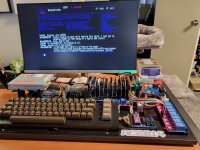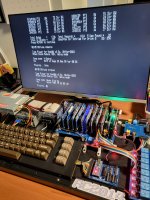skate323k137
Experienced Member
Hello all,
I wanted to share a thread about my RC2014 build. This build was an off-and-on project for 8+ months. When first booted up, here's what it looks like:
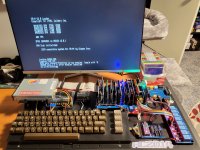
The backplane is the RC2014(TM) Pro backplane, a 12 slot backplane.
ROM/BIOS: RomWBW https://github.com/wwarthen/RomWBW
- I usually run ZP/M, but as noted on Github I can also boot other OSes: CP/M 2.2, ZSDOS, CP/M 3, NZ-COM, and more
Backplane slots in order, Left to Right
FLOCK Floppy Disk controller: https://www.tindie.com/products/weird/flock-rc2014-compatible-module-kit/
YM2149 Sound card: https://www.tindie.com/products/semachthemonkey/ym2149-sound-card-for-rc2014-retro-computer/
\_ Uses a ZXTT module for precise clock: https://www.tindie.com/products/quazar/zxtt-zx-true-tone-add-on-for-rc2014-ymay/
a single Relay delays power to this module until the PSU has fully warmed up, as the crystal would lock onto the wrong harmonic otherwise.
Primary Digital IO card: https://z80kits.com/shop/digital-i-o-module/ (ID 0 in MBASIC, displays RomWBW POST progress)
RC2014 CF storage card
RC2014 Z80 Processor card
RC2014 512K RAM / 512K ROM card
ESP8266 Wifi module with ZiModem firmware: https://z80kits.com/shop/esp8266-wifi-module/
RC2014 Dual Serial card
RC2014 Dual Clock speed module (2nd clock divided for Wifi module serial baud rate of 9600)
SC129 RC Bus Digital IO https://www.tindie.com/products/tindiescx/sc129-digital-io-module-kit-for-rc2014/
\_Hooked to a DB15 for controller input, and an isolated 8x Relay module for output. On separate address than the Primary digital IO (ID 1 in MBASIC)
Pi Zero module (discontinued, sadly) running PiGFX for 80 column HDMI output.
\_Supports USB keyboard, not in use.
Custom Breadboard with Voltmeter, USB to Serial, Rear USB power output, and accepts input from the Appledore Keyboard Adapter (C64 Keyboard)
Dual Power supplies:
One powers RC2014 and Floppy Drives
Secondary PSU powers only Isolated 8X relay module
Floppy and CF:
1.4M WDC Compatible floppy controller, formattable within CPM, bootable
FAT utility allows access to FAT12 formatted floppies (accessible on modern computer with USB floppy drive). Files must be copied in over command line to a CPM user area to be used, but it's very convenient.
CF has 8x8MB slices with various OSes and files. Also has a large FAT partition placed after this, accessible with the same stipulations as a FAT Floppy disk.
Keyboard:
This build uses a C64 Keyboard. Initially I built an Appledore adapter (https://p-l4b.github.io/appledore/) to use a C64 keyboard with Apple 1 replica/clones. In looking at the code I realized I could adapt it for this purpose, so I made my own version of the firmware appropriately credited and targeted it specifically to using CP/M (ZPM) and RomWBW: https://github.com/Alex-Kw/c64-rc2014-Keyboard/
The keyboard supports navigating wordstar documents in a relatively painless fashion among other things. The full features are listed in the github above.
Sound:
This is one of the most fun reasons to have built this thing. The card sounds great and I have placed a recording or two on my youtube:
Network:
Qterm, specifically Qterm82, was compiled to use the dual SIO of the RC2014. This version of Qterm allows use of BBS etc by way of the Zimodem/ESP8266 card.
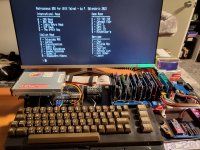
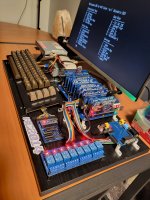
I think that's most of it, or what I can remember for now! The whole project is mounted down, and can pass the "hold it upside down and shake it" test, which was a personal requirement when assembling the final project.
This slab with rubber feet can be set down and plugged into an HDMI monitor and standard PC power cord (it has a fused and switched outlet on the back left corner) and it's ready to go. I also ran the 3.5mm from the card to a breakout board so it has a jack on the back edge of the build. I no longer use the composite video, but it has a similar passthru, the idea being that the cards themselves are never touched for setup/teardown in normal use of the system.
Questions, comments, etc all welcome.
Cheers,
Alex
I wanted to share a thread about my RC2014 build. This build was an off-and-on project for 8+ months. When first booted up, here's what it looks like:

The backplane is the RC2014(TM) Pro backplane, a 12 slot backplane.
ROM/BIOS: RomWBW https://github.com/wwarthen/RomWBW
- I usually run ZP/M, but as noted on Github I can also boot other OSes: CP/M 2.2, ZSDOS, CP/M 3, NZ-COM, and more
Backplane slots in order, Left to Right
FLOCK Floppy Disk controller: https://www.tindie.com/products/weird/flock-rc2014-compatible-module-kit/
YM2149 Sound card: https://www.tindie.com/products/semachthemonkey/ym2149-sound-card-for-rc2014-retro-computer/
\_ Uses a ZXTT module for precise clock: https://www.tindie.com/products/quazar/zxtt-zx-true-tone-add-on-for-rc2014-ymay/
a single Relay delays power to this module until the PSU has fully warmed up, as the crystal would lock onto the wrong harmonic otherwise.
Primary Digital IO card: https://z80kits.com/shop/digital-i-o-module/ (ID 0 in MBASIC, displays RomWBW POST progress)
RC2014 CF storage card
RC2014 Z80 Processor card
RC2014 512K RAM / 512K ROM card
ESP8266 Wifi module with ZiModem firmware: https://z80kits.com/shop/esp8266-wifi-module/
RC2014 Dual Serial card
RC2014 Dual Clock speed module (2nd clock divided for Wifi module serial baud rate of 9600)
SC129 RC Bus Digital IO https://www.tindie.com/products/tindiescx/sc129-digital-io-module-kit-for-rc2014/
\_Hooked to a DB15 for controller input, and an isolated 8x Relay module for output. On separate address than the Primary digital IO (ID 1 in MBASIC)
Pi Zero module (discontinued, sadly) running PiGFX for 80 column HDMI output.
\_Supports USB keyboard, not in use.
Custom Breadboard with Voltmeter, USB to Serial, Rear USB power output, and accepts input from the Appledore Keyboard Adapter (C64 Keyboard)
Dual Power supplies:
One powers RC2014 and Floppy Drives
Secondary PSU powers only Isolated 8X relay module
Floppy and CF:
1.4M WDC Compatible floppy controller, formattable within CPM, bootable
FAT utility allows access to FAT12 formatted floppies (accessible on modern computer with USB floppy drive). Files must be copied in over command line to a CPM user area to be used, but it's very convenient.
CF has 8x8MB slices with various OSes and files. Also has a large FAT partition placed after this, accessible with the same stipulations as a FAT Floppy disk.
Keyboard:
This build uses a C64 Keyboard. Initially I built an Appledore adapter (https://p-l4b.github.io/appledore/) to use a C64 keyboard with Apple 1 replica/clones. In looking at the code I realized I could adapt it for this purpose, so I made my own version of the firmware appropriately credited and targeted it specifically to using CP/M (ZPM) and RomWBW: https://github.com/Alex-Kw/c64-rc2014-Keyboard/
The keyboard supports navigating wordstar documents in a relatively painless fashion among other things. The full features are listed in the github above.
Sound:
This is one of the most fun reasons to have built this thing. The card sounds great and I have placed a recording or two on my youtube:
Network:
Qterm, specifically Qterm82, was compiled to use the dual SIO of the RC2014. This version of Qterm allows use of BBS etc by way of the Zimodem/ESP8266 card.


I think that's most of it, or what I can remember for now! The whole project is mounted down, and can pass the "hold it upside down and shake it" test, which was a personal requirement when assembling the final project.
This slab with rubber feet can be set down and plugged into an HDMI monitor and standard PC power cord (it has a fused and switched outlet on the back left corner) and it's ready to go. I also ran the 3.5mm from the card to a breakout board so it has a jack on the back edge of the build. I no longer use the composite video, but it has a similar passthru, the idea being that the cards themselves are never touched for setup/teardown in normal use of the system.
Questions, comments, etc all welcome.
Cheers,
Alex

